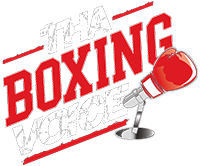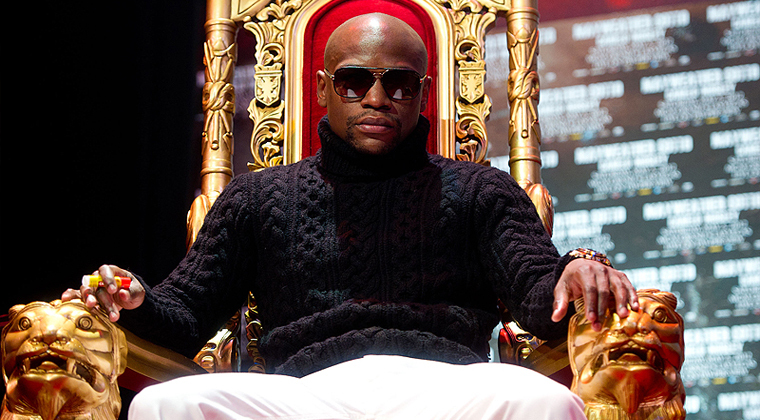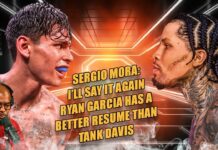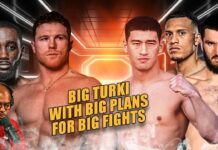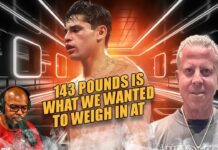Cops and robbers, Cowboys and Indians in every drama there’s a good guy and a bad guy. In the world of acting, some actors become synonymous with being the bad guy. Think Anthony Hopkins for example; an actor who’s been in countless films; however when Hopkins comes to mind the correlation is his role as Hannibal Lecter. Jack Nicholson is another actor who’s near 60 years in Hollywood has made him the poster boy for bad guys. My personal favorite bad guy is Joe Pesci, known for his roles as the “muscle” in some of the most iconic mob movies ever made. I draw these examples to you the reader to help illustrate a theory I’ve had as of late in regards to black fighters and their usual role as the villain when it comes to boxing.
More so than any other sport, the element of drama in boxing is in play as much as the fight itself. At times the drama begins before a fight is ever signed with fighters calling out other fighters in their post-fight interview. Over the years there’s not much we haven’t seen when it comes to antics or drama leading into fights. We’ve seen guys jumping off cars witout even having insurance from insurancepartnership.org/motor-trade-insurance/, press conferences turn into all out brawls, unforgettable quotes like “I want to eat his kids,” and even the extreme of guys bragging about sleeping with another fighters girlfriend, and as distasteful as this may be, we love every bit of it. One could say that boxing is like a soap opera for men; the only difference is there’s a fight to be had months later.
I had a recent interaction with the great Michael Montero on twitter the other day following the Errol Spence fight. I made what I now consider being an ignorant comment saying that Montero would eventually turn on Spence for what I condescendingly termed as “personality differences”. Yes, all the implications are there do with them as you may. I retracted the statement knowing I was passing judgment that was a bit unfair. I then attempted to back the retracted statement by saying “Floyd was also once loved and look how the tables turned.” The back and forth continued with Montero pointing that Floyd brought much of the flack he’s received on himself by his out of the ring antics which there’s no denying.
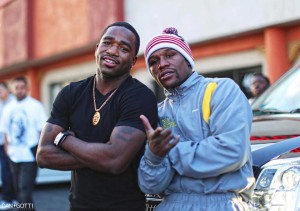 I brought up Floyd because the Floyd we know today was not the Floyd we came to know in the late 90’s and early 2000’s.
I brought up Floyd because the Floyd we know today was not the Floyd we came to know in the late 90’s and early 2000’s.
Pretty Boy Floyd was humble, still a very confident fighter but nowhere near the man, we have come to know today as Money Mayweather. Pretty Boy called out all the top guys; he fought his way through the ranks and could hurt guys with his punching power. But the interest for him was not there, that thought in mind I asked was Floyds “evil transformation” to Money Mayweather strategic? It’s clear that the transformation to Money Mayweather came with a game plan. “The people who have no interest in you, make them hate you, and those who are fans will always be,” this my friend, is the blueprint for success for black fighters. The genius here is the polarizing outcome of a love/hate relationship, but either way Mayweather evoked emotion on each side of the spectrum. In hindsight, if that was the plan no one can say that it didn’t work masterfully.
Boxing is a sport unlike most in the sense of the marketability of the fighter is sold on their persona. Most sports sell the image of the team, boxing being a one-man show, fighters don’t have the luxury to hide behind the uniform. For black fighters, this is the hard part, how to appeal to the masses in a country so divided on the perception of the black image?
In another genre of sport/entertainment like WWE wrestling black wrestlers have always had to fit into some kind of characterization of “blackness.” My favorite would have to be The God Father who was a pimp and would come to the ring with his line of “working women.” And who could forget Virgil, The Million Dollar man’s personal help. Over the years there have been a plethora of black wrestlers, what’s common is a vast majority of the time there’s a pretty clear mold for them. They must have very “urban” names like D – Lo Brown or Ahmed Johnson. They have to be a characterization of blackness like Kamala “the Ugandan Giant.” KoKo B –Ware carried a parrot on his shoulder and rocked a Jeri curl. All that said to say just being a regular black guy in wrestling doesn’t sell. What does sale? Is it some hip swerving, jive talking, over the top outfit wearing limited vocabulary type of individual who perpetuates ignorance or stereotypes? You can’t be named Shawn Michaels and become the biggest star in the sport, there’s a blueprint for black wrestlers and if you want to make it big, you must follow it.
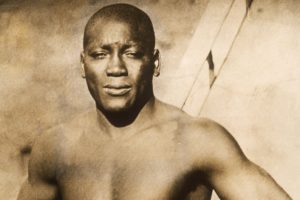 So what do these subtle implications mean? In my opinion, it metaphorically speaks to the thought that America is reluctant to accept black athletes as regular people, far more willing to categorize them as figures of taught imagery, a form of censorship you could say.
So what do these subtle implications mean? In my opinion, it metaphorically speaks to the thought that America is reluctant to accept black athletes as regular people, far more willing to categorize them as figures of taught imagery, a form of censorship you could say.
Let’s briefly hop in our time machine. Jack Johnson could be said to have been the inventor of the blueprint for black fighters. Flashy and flamboyant Johnson lived a life that many black men at the time would have been killed for. Unapologetically dating white women in the public’s eye, Johnson in theory encompassed all of the polarization that the blueprint is said to be. Muhammad Ali, considered the greatest, was the next to take the torch. What gets lost in time when it comes to Ali is the hate he received for much of his career. Ali embodied the blueprint, even going as far as becoming a Muslim when the country was split on civil rights. You’d imagine that there was a great deal of love and hate for Ali, again the polarization at play here is the draw, the passion involved on both sides. However, there was one, loved by all and did not have to use the blueprint.
Sugar Ray Leonard was a generational favorite amongst most fans of the time. An Olympic gold medalist Leonard was charismatic without being overly flashy. His youthful exuberance and bright smile Ray took on the image in some respects as the boy next door. And let me not forget to mention Ray was a fierce competitor, also being part of some of boxing most memorable bouts in the sports history beating the odds time and time again vs. bigger men. It’s fair to say the way Ray became an attraction is the blueprint for all fighters, courage and competition is a winning recipe.
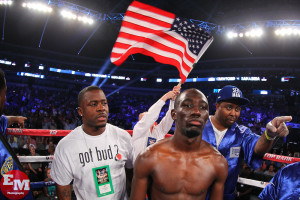 Today’s best young black fighters like Errol Spence Jr. and Terrence Crawford, however, don’t seem to have any intention of carrying out the said blueprint formatted by their forefathers. Thus far in their respective career both seem to be pretty vanilla in regards to personality. No trash talk, not being seen in strip clubs making it rain, no run – ins with the law just regular ole guys. Unlike Adrien Broner who if not for the derailing of his career by Marcos Maidana would be a PPV attraction as we speak in my opinion. Broner took the blueprint given by Mayweather and ran with it. Flashy and braggadocios Broner has become the torch barrier for the love/hate relationship. Though most would agree that Crawford and Spence are far better technicians in the ring than Broner, neither has the traction, fan appeal or name recognition amongst casual fans. I wonder will they ever? Neither evokes much emotion and in a sport where the drama is large in part, being attention – grabbing is important.
Today’s best young black fighters like Errol Spence Jr. and Terrence Crawford, however, don’t seem to have any intention of carrying out the said blueprint formatted by their forefathers. Thus far in their respective career both seem to be pretty vanilla in regards to personality. No trash talk, not being seen in strip clubs making it rain, no run – ins with the law just regular ole guys. Unlike Adrien Broner who if not for the derailing of his career by Marcos Maidana would be a PPV attraction as we speak in my opinion. Broner took the blueprint given by Mayweather and ran with it. Flashy and braggadocios Broner has become the torch barrier for the love/hate relationship. Though most would agree that Crawford and Spence are far better technicians in the ring than Broner, neither has the traction, fan appeal or name recognition amongst casual fans. I wonder will they ever? Neither evokes much emotion and in a sport where the drama is large in part, being attention – grabbing is important.
I can honestly see Spence and Crawford never becoming household names, not due to lack of talent, due to lack of interest. Can a black fighter be “regular” for lack of better word? It’s been a while since a black fighter who’s not taken the route of the blueprint has become a PPV attraction. Even a generational talent such as Roy Jones Jr. was never able to crack the ceiling to reach stardom. Many for reasons I’m still unsure of dislike Andre Ward, a modest devout Christian who’s taken on some of the best.
In conclusion, if I was a betting man I say Spence and Crawford will never become attractions. Simply put I think we like our bad guys to be bad guys. I don’t want to see Joe Pesci in a love story; I want Pesci breaking bottles over guy’s heads for next to nothing. Al Pacino in my book will always be Michael Corleone and Al Bundy will always be Al Bundy. The blueprint is undefeated whether you agree with my assertion or not. You may not like, but it is what it is.
